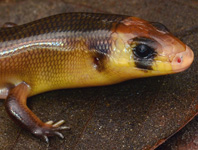Abstract
The Areias System, situated in the Atlantic Forest, is considered a hotspot of troglobitic diversity in Brazil. Herein we describe two new sympatric, troglobitic species of Girardia occurring in this system. Both species show minute eyes; one of them has a whitish body, and the other scattered, fine pigmentation over the dorsal surface. Regarding the copulatory apparatus, one of the species shows a bulbar cavity with multiple diverticula and a bursal canal of the angled type, whereas the other has a single, ovoid bulbar cavity and a smoothly curved bursal canal, among other distinguishing features. Thus, each species can be differentiated by a unique combination of features in its external morphology and copulatory apparatus. Both present a restricted distribution, occurring in a group of pools in travertine rock formed by water from the epikarst. The morphological features of both species and this sampling location indicate that both species are stygobionts
References
De Azara, L.N. & Ferreira, R.L. (2013) The first troglobitic Cryptops (Trigonocryptops) (Chilopoda: Scolopendromorpha) from South America and the description of a non-troglobitic species from Brazil. Zootaxa, 3709 (5), 432–444.
https://doi.org/10.11646/zootaxa.3709.5.2Galindo, L.C. & Câmara, I.G. (2005) Status do hotspot Mata Atlântica: uma síntese. In: Galindo-Leal, C. & Câmara, I.G. (Eds.), Mata Atlântica; biodversidade, ameaças e perspectivas. Centro de Ciências Aplicadas e Biodversidade, Belo Horizonte, pp. 1–471.
Hardin, G. (1960) The competitive exclusion principle. Science, 131 (3409), 1292–1297
https://doi.org/10.1126/science.131.3409.1292Kawakatsu, M. & Froehlich, E.M. (1992) Freshwater planarians from four caves of Brazil: Dugesia paramensis (Fuhrmann, 1914) and Dugesia sp. (Turbellaria, Tricladida, Paludicola). Journal of the Speleological Society of Japan, 17, 1–19.
Kawakatsu, M., Hauser, J. & Friedrich, S.M.G. (1983) Morphological, karyological and taxonomic studies of freshwater planarians from South Brazil. IV. Dugesia anderlani sp. nov. (Turbellaria: Tricladida: Paludicola), a new species from São Leopoldo in estado de Rio Grande do Sul. Annotationes Zoologicae Japonenses, 56 (3), 196–208.
Kawakatsu, M. & Mitchell, R.W. (1981) An additional note on Dugesia guatemalensis Mitchell et Kawakatsu (Turbellaria: Tricladida: Paludicola), a troglophilic planarian from México. Annales de Spéléologie, 6, 37–41.
Kenk, R. (1975) Freshwater triclads (Turbellaria) of North America. VIII. Dugesia arizonensis, new species. Proceedings of the Biological Society of Washington, 88, 113–120.
Marcus, E. (1954) Turbellaria. Reports of the Lund University Expedition 1948-49. Kungliga Fysiografiska Sällskapets Handlingar, N.F., 64 (13), 1–115.
Mitchell, R.W. & Kawakatsu, M. (1973a) A new cave-adapted planarian (Tricladida, Paludicola, Planariidae) from Chiapas, Mexico. Association for Mexican Cave Studies Bulletin, 5, 165–170.
Mitchell, R.W. & Kawakatsu, M. (1973b) Freshwater cavernicole planarians from Mexico: new troglobitic and troglophilic Dugesia from caves of the Sierra de Guatemala. Annales de Spéléologie, 27, 639–681.
Rodrigues, S.G., Bueno, A.A.D.P. & Ferreira, R.L. (2014) A new troglobiotic species of Hyalella (Crustacea, Amphipoda, Hyalellidae) with a taxonomic key for the Brazilian species. Zootaxa, 3815 (2), 200–214.
https://doi.org/10.11646/zootaxa.3815.2.2Romeis, B. (1989) Mikroskopische Technik. Urban und Schwarzenberg, München, 697 pp.
Sluys, R., Kawakatsu, M. & Ponce de León, R. (2005) Morphological stasis in an old and widespread group of species: contribution to the taxonomy and biogeography of the genus Girardia (Platyhelminthes, Tricladida, Paludicola). Studies on Neotropical Fauna and Environment, 40 (2), 155–180.
https://doi.org/10.1080/01650520500070220Sluys, R. (1992) Synopsis of the freshwater triclads of the Caribbean (Platyhelminthes, Tricladida, Paludicola). Studies on the Natural History of the Caribbean Region, 71 (1), 1–23.
Souza, E.T., Morais, A.L.N., Bichuette, M.E. & Leal-Zanchet, A.M. (2016) Two new species of freshwater flatworms (Platyhelminthes: Tricladida: Continenticola) from South American caves. Zootaxa, 4092 (1), 107–121.
https://doi.org/10.11646/zootaxa.4092.1.6
Souza, E.T., Morais, A.L.N., Cordeiro, L.M. & Leal-Zanchet, A.M. (2015) The first troglobitic species of freshwater flatworm of the suborder Continenticola (Platyhelminthes) from South America. ZooKeys, 470, 1–16.
https://doi.org/10.3897/zookeys.470.8728Souza-Silva, M.S. & Ferreira, R.L. (2016) The first two hotspots of subterranean biodiversity in South America. Subterranean Biology, 19, 1–21.
https://doi.org/10.3897/subtbiol.19.8207Trajano, E. (2000) Cave faunas in Atlantic Tropical Rain Forest: composition, ecology and conservation. Biotropica, 32, 882–893.
https://doi.org/10.1111/j.1744-7429.2000.tb00626.xTrajano, E. (2007) The challenge of estimating the age of subterranean lineages: examples from Brazil. Acta carsologica, 36 (1), 191–198.
https://doi.org/10.3986/ac.v36i1.221

